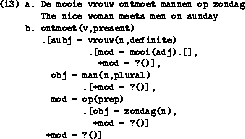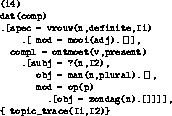


Next: The definition of Up: AN APPROACH TO SENTENCE-LEVEL Previous: MiMo
The basic model
In this section an overview of the MiMo system will be given as far as is relevant for the rest of this paper. The system's architecture is as in (8).

In (8) it is indicated that a text in a source language is parsed into an interface structure (I). This I-structure, in its turn, is translated into an interface structure in the target language. From this structure the target language text can then be generated. In this paper, mainly the construction of I-structures, through analysis and through transfer, will be focused on, hence the importance of understanding what these structures look like in MiMo terms.
An I-structure is a tree. The mother node consists of the lexical identifier (LI, the name of the lexical element), possibly provided with a set of features, and a number of slots. Slots can be filled with other I-structures that meet the requirements specified by the slots. (9) is an example of an I-structure.

The I-structure (9) has an LI 'kiss' and two slots, an object slot and a subject slot. Fillers of these slots will have to be nominal. The subject slot has been filled by an I-structure that has 'john' as LI, the object slot by the I-structure with LI 'mary'. We will abbreviate structures like these as in (10) henceforth. So, an I-structure consists of a certain LI, a feature bundle in parenthesis and a number of slots in square brackets preceded by a dot. A slot is made up of the name followed by the equal sign and the I-structure that fills it.
Possible I-structures are defined in the lexicon. Distinct (phrase structure) rules that define I-structures are not needed, all structures are specified in the lexicon. Generalizations should be expressed in the lexicon as well. The advantage of this approach is the possibility of defining all subcategorization phenomena directly. So, only coherent structures in the sense of LFG (Bresnan 1982) are built. In the lexicon, the slots have not yet been filled by other I-structures. The I-structure for 'kiss' looks like (11) in the lexicon, the question marks indicate that the slot are still empty. In (12) the lexical representation of 'john' is given, which has no slots.

When an I-structure fills the slot of some other I-structure, the features
of the slot and those of the I-structure are unified (see e.g.
Shieber 1987). The I-structures represented so far were simplified for
the sake of readability. In reality, there is the possibility of indicating
whether slots are optional or obligatory. Slots can also be marked
with the Kleene star. The effect of this operator is that
the slot is copied when
an I-structure fills the slot. The I-structure will fill the copy and the
original slot remains as it was. The slot can be filled
several times by I-structures in this way. The slot for modifiers
is in fact marked with the Kleene star .
An I-structure for (13a) looks like (13b)
.
An I-structure for (13a) looks like (13b) .
.

Some words in the lexicon can have the special feature 'anaphor'.
I-structures having this feature will have to be bound by an antecedent in
the end. Examples of these are pronouns and reflexives.
This requirement also holds for empty slots.
They are considered anaphoric and will have to be bound as well
unless we deal with optional slots. Binding of I-structures happens
through anaphoric rules. In the next section we will show the way
these rules are formulated. The final structure of (13a) will be (14).
In (14), a relation between the topic (I1) and the embedded subject
position (I2) is established
is established .
.

The subordinate complementizer is also regarded as a lexical word.
Even sentences that do not show a complementizer at surface are assigned one.
This is not in any way intrinsic to MiMo but makes a uniform
account of several phenomena possible. This type of complementizer
has two slots:
an optional slot for topics or wh-words and a slot for a verb construction.



Next: The definition of Up: AN APPROACH TO SENTENCE-LEVEL Previous: MiMo
Gertjan van Noord
Fri Nov 25 13:16:14 MET 1994